在中国农业电子商务平台的建设
我国农业电子商务发展对策
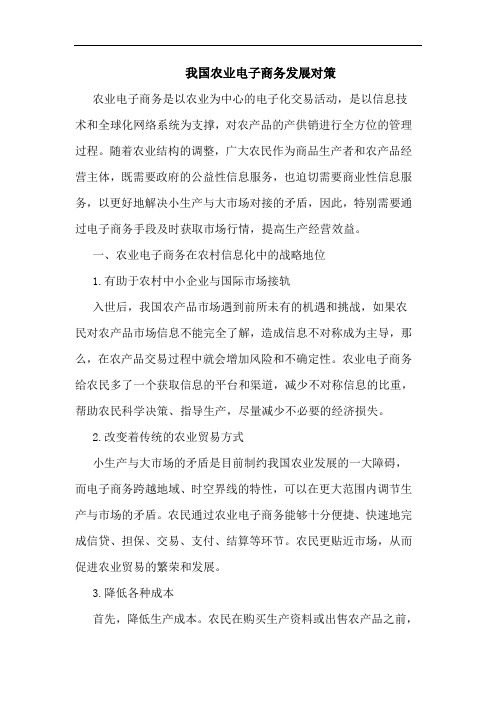
我国农业电子商务发展对策农业电子商务是以农业为中心的电子化交易活动,是以信息技术和全球化网络系统为支撑,对农产品的产供销进行全方位的管理过程。
随着农业结构的调整,广大农民作为商品生产者和农产品经营主体,既需要政府的公益性信息服务,也迫切需要商业性信息服务,以更好地解决小生产与大市场对接的矛盾,因此,特别需要通过电子商务手段及时获取市场行情,提高生产经营效益。
一、农业电子商务在农村信息化中的战略地位1.有助于农村中小企业与国际市场接轨入世后,我国农产品市场遇到前所未有的机遇和挑战,如果农民对农产品市场信息不能完全了解,造成信息不对称成为主导,那么,在农产品交易过程中就会增加风险和不确定性。
农业电子商务给农民多了一个获取信息的平台和渠道,减少不对称信息的比重,帮助农民科学决策、指导生产,尽量减少不必要的经济损失。
2.改变着传统的农业贸易方式小生产与大市场的矛盾是目前制约我国农业发展的一大障碍,而电子商务跨越地域、时空界线的特性,可以在更大范围内调节生产与市场的矛盾。
农民通过农业电子商务能够十分便捷、快速地完成信贷、担保、交易、支付、结算等环节。
农民更贴近市场,从而促进农业贸易的繁荣和发展。
3.降低各种成本首先,降低生产成本。
农民在购买生产资料或出售农产品之前,可以通过网络进行价格比对,选择最合适的交易者。
同时,还可以在网上通过集体采购、招标等手段来降低生产成本。
另外,通过互联网可以获得市场技术。
其次,有效降低交易成本。
农业电子商务可以减少第三方或中介组织的参与,农民与消费者通过因特网可以直接进行交易,减少中间交易成本。
再次,有效降低营销成本。
使用互联网广告,其成本要比传统广告媒体节省75%。
利用网络向全球发布本地农产品资源信息,宣传、推介本地丰富的优质农产品。
同时将本地区农产品推行标准化生产,创建网上农产品超市,不断扩大网上交易规模,逐步引入期货交易,发展“订单式农业”。
二、如何加快发展农业电子商务1.加强电子商务意识农业电子商务要发展,观念要先行。
农业电子商务发展现状
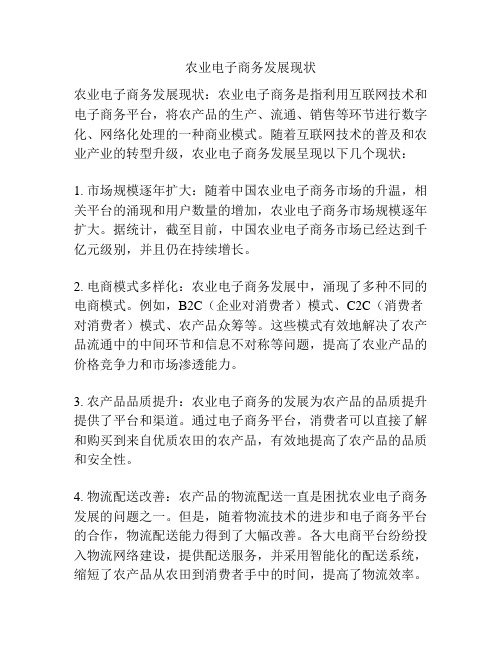
农业电子商务发展现状农业电子商务发展现状:农业电子商务是指利用互联网技术和电子商务平台,将农产品的生产、流通、销售等环节进行数字化、网络化处理的一种商业模式。
随着互联网技术的普及和农业产业的转型升级,农业电子商务发展呈现以下几个现状:1. 市场规模逐年扩大:随着中国农业电子商务市场的升温,相关平台的涌现和用户数量的增加,农业电子商务市场规模逐年扩大。
据统计,截至目前,中国农业电子商务市场已经达到千亿元级别,并且仍在持续增长。
2. 电商模式多样化:农业电子商务发展中,涌现了多种不同的电商模式。
例如,B2C(企业对消费者)模式、C2C(消费者对消费者)模式、农产品众筹等。
这些模式有效地解决了农产品流通中的中间环节和信息不对称等问题,提高了农业产品的价格竞争力和市场渗透能力。
3. 农产品品质提升:农业电子商务的发展为农产品的品质提升提供了平台和渠道。
通过电子商务平台,消费者可以直接了解和购买到来自优质农田的农产品,有效地提高了农产品的品质和安全性。
4. 物流配送改善:农产品的物流配送一直是困扰农业电子商务发展的问题之一。
但是,随着物流技术的进步和电子商务平台的合作,物流配送能力得到了大幅改善。
各大电商平台纷纷投入物流网络建设,提供配送服务,并采用智能化的配送系统,缩短了农产品从农田到消费者手中的时间,提高了物流效率。
5. 电商扶贫助农:农业电子商务的发展为贫困地区提供了脱贫致富的新途径。
通过电商平台,农产品可以直接面向全国市场,扩大销售渠道,提高农民的收入。
同时,电商平台还通过直销模式和分红方式,有效地推动了贫困地区的农业产业发展,带动了当地农民的脱贫致富。
总的来说,农业电子商务的发展极大地改变了传统农业的生产和销售模式,提高了农产品的市场竞争力和品质水平。
随着技术的不断创新和政策的不断扶持,农业电子商务有望在未来继续迎来更大的发展机遇。
中国农产品电子商务的现状与发展趋势
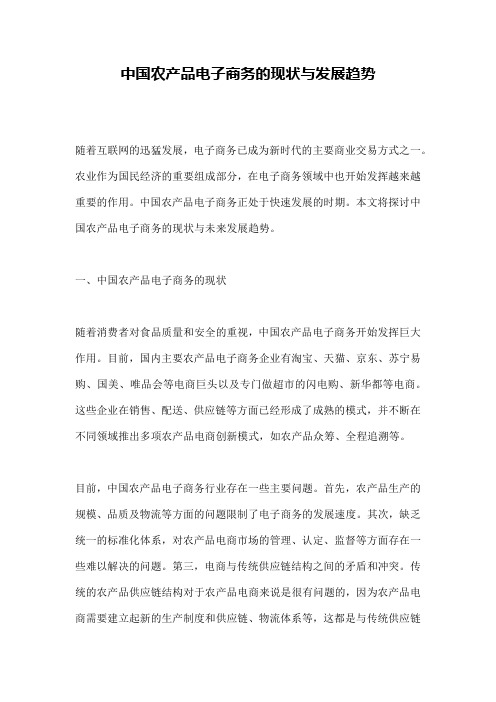
中国农产品电子商务的现状与发展趋势随着互联网的迅猛发展,电子商务已成为新时代的主要商业交易方式之一。
农业作为国民经济的重要组成部分,在电子商务领域中也开始发挥越来越重要的作用。
中国农产品电子商务正处于快速发展的时期。
本文将探讨中国农产品电子商务的现状与未来发展趋势。
一、中国农产品电子商务的现状随着消费者对食品质量和安全的重视,中国农产品电子商务开始发挥巨大作用。
目前,国内主要农产品电子商务企业有淘宝、天猫、京东、苏宁易购、国美、唯品会等电商巨头以及专门做超市的闪电购、新华都等电商。
这些企业在销售、配送、供应链等方面已经形成了成熟的模式,并不断在不同领域推出多项农产品电商创新模式,如农产品众筹、全程追溯等。
目前,中国农产品电子商务行业存在一些主要问题。
首先,农产品生产的规模、品质及物流等方面的问题限制了电子商务的发展速度。
其次,缺乏统一的标准化体系,对农产品电商市场的管理、认定、监督等方面存在一些难以解决的问题。
第三,电商与传统供应链结构之间的矛盾和冲突。
传统的农产品供应链结构对于农产品电商来说是很有问题的,因为农产品电商需要建立起新的生产制度和供应链、物流体系等,这都是与传统供应链结构存在矛盾的。
二、中国农产品电子商务的发展趋势中国农产品电子商务未来的发展趋势主要有以下几点:1、从单一模式向多元化模式转变随着市场竞争加剧和技术不断进步,中国农产品电子商务将逐渐向多元化模式转变。
未来的农产品电商将会进一步拓展其业务范围,提供多种服务,包括:众筹、全程追溯、供应链、仓储物流等。
2、全程追溯体系的推广全程追溯体系将是农产品电商的必然趋势,也是保障食品安全、提升消费者消费信心的关键。
因此,未来的农产品电商将会更加重视产品质量和安全管理,加强食品安全检测和产品信息公示,保证消费者的权益和安全。
3、农产品电商与供应链的结合农产品电商与供应链的结合将是未来农产品电商的重要发展方向。
电商企业将会通过合理设计产品线、与农户建立合作关系、提高生产效率,加快流通节奏,从而达到供应链的优化目的。
农产品电子商务发展的现状问题对策

农产品电子商务发展的现状问题对策*.农产品电子商务发展面临的制约因素*农产品电商建设资金投入不足,农村电子商务基础设施落后。
农产品电商的发展主要是以完善的基础设施为支撑,目前,很多农村在电商领域的基础设施短板问题仍没有得到解决。
农村电商基础设施建设需要大量固定资本的投资,目前资金来源主要以国家财政为主。
然而由于现存的财政赤字问题使得国家在农村电商建设中财政投入规模远远低于实际需求,尤其是在一些偏远地区,进行大规模电商建设的成本很高,而国家对电商的发展缺乏长期有效的支持体系,导致某些地区农产品冷链“最先一公里”和物流“最后一公里”等农村电商物流体系建设滞后,地区物流设施规模小、发展慢,与发达国家差距较大。
据统计,目前我国农产品运输冷藏车辆总数仅为日本的十一分之一,冷藏保温车在我国货车中的比例仅为左右,而发达国家是*%~*%。
而且在部分地区冷链物流发展还未起步,冷链物流的水平低下直接制约了农产品电商的发展。
因此现阶段,加强我国农村地区的电商基础设施建设很有必要。
*缺乏专业型和实用型的电商人才,无法有效指导农业生产。
农产品电商的发展需要大批既懂互联网、又懂农业的复合型人才,目前我国农村劳动力大多以中老年为主,文化程度普遍较低,很难学习和掌握互联网技术,导致一部分农村信息基础设施的实际作用没有被充分发挥出来,无法有效发挥电商在农业发展中的作用。
与此同时,实用型人才比较少,*年我国农村实用人才约*万人,仅占农业劳动力人口的*%,电商作为一种对实践要求比较高的市场模式,涉及管理运营、实践操作、资源整合以及具体的战略定位和实际运营等问题,现有的农业技术人员多是理论知识较高,大多没有真正从事过农业生产和电商营销实践,离产业发展需求、服务群众需要有很大差距。
无法有效指导农民利用“互联网+”、农业信息平台等现代科技手段进行市场分析和销售,导致现代科学技术在农村应用缓慢,阻碍着农业的进一步发展。
*电商支持政策缺乏针对性,政策效果难以显现。
毕业论文浅议电子商务在中国农村的发展现状及趋势分析
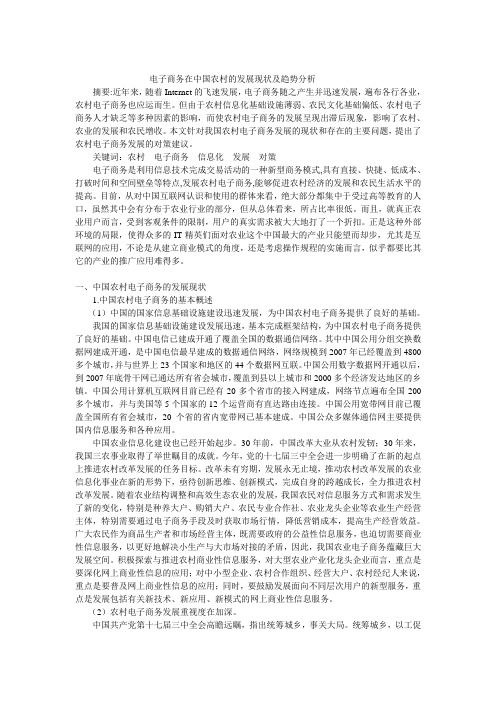
电子商务在中国农村的发展现状及趋势分析摘要:近年来,随着Internet的飞速发展,电子商务随之产生并迅速发展,遍布各行各业,农村电子商务也应运而生。
但由于农村信息化基础设施薄弱、农民文化基础偏低、农村电子商务人才缺乏等多种因素的影响,而使农村电子商务的发展呈现出滞后现象,影响了农村、农业的发展和农民增收。
本文针对我国农村电子商务发展的现状和存在的主要问题,提出了农村电子商务发展的对策建议。
关键词:农村电子商务信息化发展对策电子商务是利用信息技术完成交易活动的一种新型商务模式,具有直接、快捷、低成本、打破时间和空间壁垒等特点,发展农村电子商务,能够促进农村经济的发展和农民生活水平的提高。
目前,从对中国互联网认识和使用的群体来看,绝大部分都集中于受过高等教育的人口,虽然其中会有分布于农业行业的部分,但从总体看来,所占比率很低。
而且,就真正农业用户而言,受到客观条件的限制,用户的真实需求被大大地打了一个折扣。
正是这种外部环境的局限,使得众多的IT精英们面对农业这个中国最大的产业只能望而却步,尤其是互联网的应用,不论是从建立商业模式的角度,还是考虑操作规程的实施而言,似乎都要比其它的产业的推广应用难得多。
一、中国农村电子商务的发展现状1.中国农村电子商务的基本概述(1)中国的国家信息基础设施建设迅速发展,为中国农村电子商务提供了良好的基础。
我国的国家信息基础设施建设发展迅速,基本完成框架结构,为中国农村电子商务提供了良好的基础。
中国电信已建成开通了覆盖全国的数据通信网络。
其中中国公用分组交换数据网建成开通,是中国电信最早建成的数据通信网络,网络规模到2007年已经覆盖到4800多个城市,并与世界上23个国家和地区的44个数据网互联。
中国公用数字数据网开通以后,到2007年底骨干网已通达所有省会城市,覆盖到县以上城市和2000多个经济发达地区的乡镇。
中国公用计算机互联网目前已经有20多个省市的接入网建成,网络节点遍布全国200多个城市,并与美国等5个国家的12个运营商有直达路由连接。
我国农业电子商务平台的构建方案研究
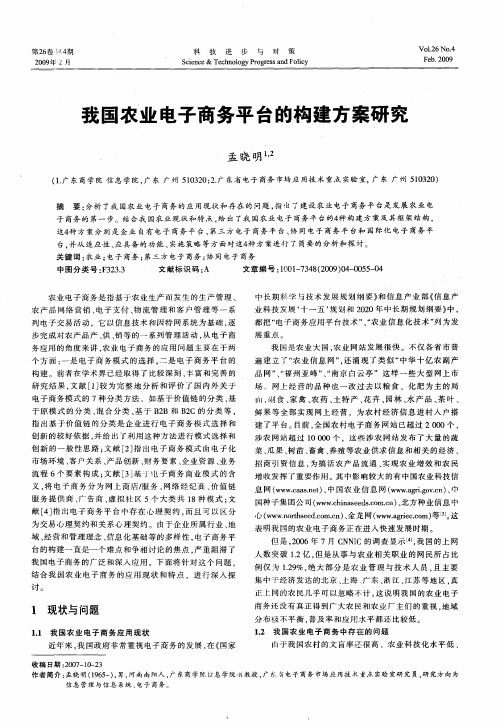
这4 方案 分 别是 企业 自有 电子 商务 平 台、 种 第三 方 电子 商务 平 台、 同 电子 商务 平 台和 国际化 电子 商务 平 协 台. 并从 适 应性 、 具备 的功 能 、 应 实施 策略 等 方 面对这4 方案 进行 了简要 的分析 和探 讨 。 种
列 电子 交易 活 动 ,它以 信息技 术 和 因特 网系统 为基 础 , 逐 步 完成 对农 产 品产 、 、 等 的~ 系列管 理 活动 , 电子 商 供 销 从 务 应用 的角 度来 讲 , 农业 电子商 务 的应用 问题 主 要在 于两
我 国是农 业大 国 , 农业 网站发 展很 快 。不仅 各 省市 普
场 。 网 上 经 营 的 品 种 也 一 改 过 去 以 粮 食 、化 肥 为 主 的 局
I, 食 、 禽 、 药 、 ( 1 家 i I 农 土特 产 、 卉 、 花 园林 、 产 品 、 叶 水 茶 鲜 果 等全 部 实现 网上经 营 ,为农 村 经济 信 息 进 村入 户 搭 建 了平 台。 目前 , 国农 村 电子商 务 网站 已超 过 20 0个 , 全 0
(. 东 商 学 院 信 息 学 院 , 东 广 州 5 0 2 2广 东省 电 子 商 务 市 场 应 用技 术 重 点 实 验 室 , 东 广 州 5 0 2 ) 1广 广 1 3 0;. 广 1 3 0
摘 要 : 分析 了我 国农 业 电子 商务 的应 用现 状和 存在 的 问题 , 出 了建设 农 业 电子 商务 平 台是 发展 农 业 电 指
农村电子商务发展现状、存在问题与对策
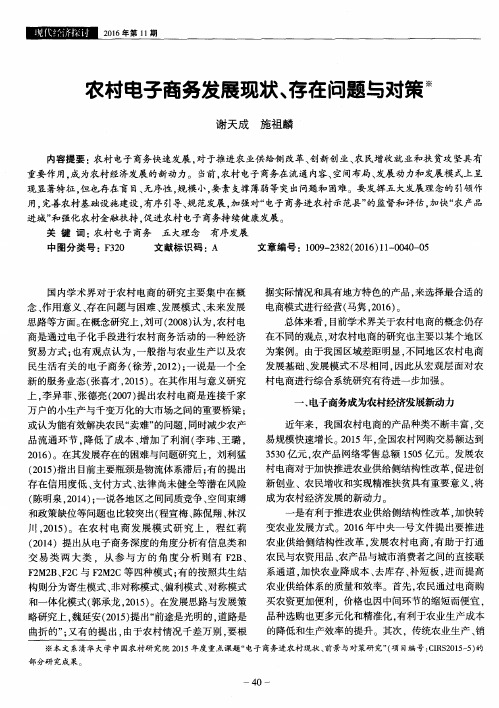
一
和政策缺位等问题也 比较突出( 程宣梅 、 陈侃翔 、 林汉 川, 2 0 1 5 ) 。在 农村 电商发 展模式研 究 上 ,程红 莉 ( 2 0 1 4 )提出从电子商务深度 的角度分析有信息类和 交 易 类 两 大 类 .从 参 与 方 的 角 度 分 析 则 有 F 2 B、 F 2 M 2 B 、 F 2 C与 F 2 M 2 C等 四种模式 ; 有的按照共生结 构则分为寄生模式、 非对称模式 、 偏利模式 、 对称模式
对物流 、 保鲜等要求比较高 , 线上销售难度较大 。 东部沿海地区发展水平明显高于中西部地 区。 已有研 究表明 : 我 国农村 电商发展地区间差距较大 , 且与当 地经济发展水平呈正相关关系( 郑亚琴 , 2 0 0 7 ) 。2 0 1 4 年全国 2 1 2 个淘宝村主要分布在 l 0 个省市 ,其中浙 江、 广东 、 福建 、 河北 、 江苏和 山东分别达到 6 2 个、 5 4
优势创造有利条件。因此, 国务院扶贫办积极与京东、
阿里、 苏宁等企业合作 , 如2 0 1 6 年1 月与京东签署“ 电
商精准扶贫战略合作框架协议” ,提出双方共同探索 “ 产业扶贫 、 创业扶贫 、 用工扶贫” 三大模式 , 并将在 8 3 2 个贫困县中选择 2 0 0 个县作为电商扶贫示范县。
农村电商平台swot分析(农村电商平台发展现状与趋势)
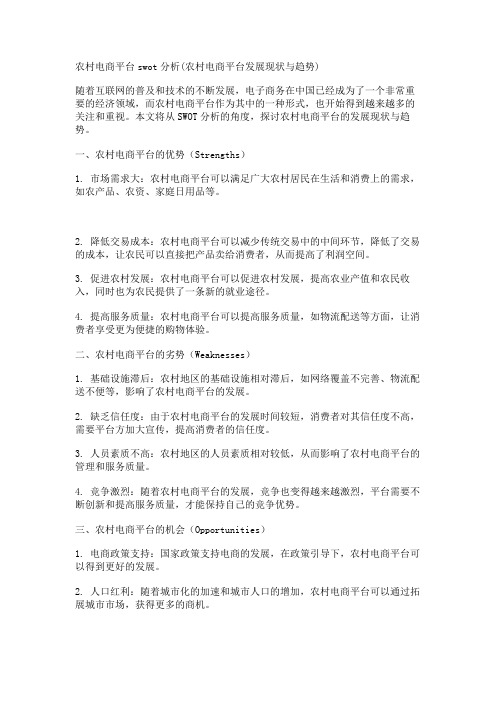
农村电商平台swot分析(农村电商平台发展现状与趋势)随着互联网的普及和技术的不断发展,电子商务在中国已经成为了一个非常重要的经济领域,而农村电商平台作为其中的一种形式,也开始得到越来越多的关注和重视。
本文将从SWOT分析的角度,探讨农村电商平台的发展现状与趋势。
一、农村电商平台的优势(Strengths)1. 市场需求大:农村电商平台可以满足广大农村居民在生活和消费上的需求,如农产品、农资、家庭日用品等。
2. 降低交易成本:农村电商平台可以减少传统交易中的中间环节,降低了交易的成本,让农民可以直接把产品卖给消费者,从而提高了利润空间。
3. 促进农村发展:农村电商平台可以促进农村发展,提高农业产值和农民收入,同时也为农民提供了一条新的就业途径。
4. 提高服务质量:农村电商平台可以提高服务质量,如物流配送等方面,让消费者享受更为便捷的购物体验。
二、农村电商平台的劣势(Weaknesses)1. 基础设施滞后:农村地区的基础设施相对滞后,如网络覆盖不完善、物流配送不便等,影响了农村电商平台的发展。
2. 缺乏信任度:由于农村电商平台的发展时间较短,消费者对其信任度不高,需要平台方加大宣传,提高消费者的信任度。
3. 人员素质不高:农村地区的人员素质相对较低,从而影响了农村电商平台的管理和服务质量。
4. 竞争激烈:随着农村电商平台的发展,竞争也变得越来越激烈,平台需要不断创新和提高服务质量,才能保持自己的竞争优势。
三、农村电商平台的机会(Opportunities)1. 电商政策支持:国家政策支持电商的发展,在政策引导下,农村电商平台可以得到更好的发展。
2. 人口红利:随着城市化的加速和城市人口的增加,农村电商平台可以通过拓展城市市场,获得更多的商机。
3. 产品多样化:农村地区的产品种类多样,可以通过农村电商平台,将更多的产品推向市场,满足消费者的需求。
4. 服务升级:随着技术的发展和物流配送的完善,农村电商平台可以提供更为便捷的服务,从而吸引更多的消费者。
我国农业电子商务平台的构建方案研究
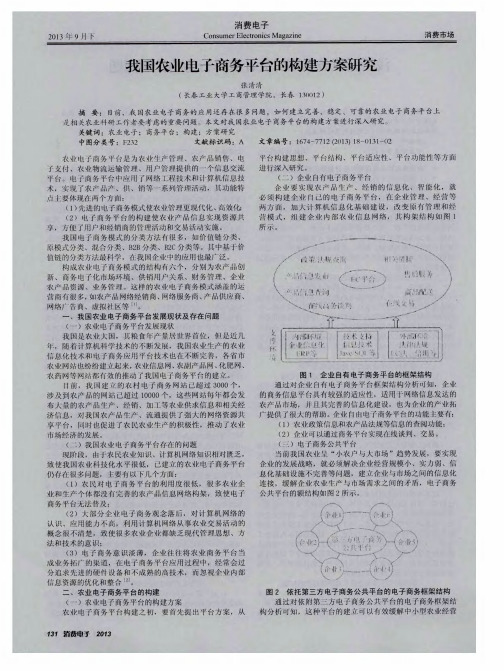
考虑在 报表 附注 中专 门增加对关联 方信息 以及债务 重组信息 披露 的综合分析报 告,增加披露 的效果,对有效披 露关联方 重组起很好 的规范作用 。 参考文 献: f 1 1中华人 民共和 国财政 部 . 企业会 计 准则 第 1 2号—— 债务重组 f M】 . 北京 : 经济科 学 出版社 , 2 0 0 6 . [ 2 ] 葛 家澎 . 关于 高质 量会计 准则的 几个 问题 Ⅱ 】 . 会 计研
究 , 2 0 0 2 , 1 0 : 3 - 5 .
要求 在报表 附注中增加披 露, 由独立第 三方签字 盖章的 债务人 持续经营评 估证 明。这样一来 ,在债 权人和债 务人签 订债务 重组协议前 ,不得不寻求 独立的第三 方对债务人 的持 续经营 能力做一客 观评估 ,而作 为一个独立 的机构 ,也会 将
证 明
重 组双方置 于平 等的地位 ,公正地完成债 务重组评估工作 , 提 高 了信 息 的可 信 度 。 3 .对于涉及关联方 的债 务重组披露 ,就 目前来看 ,依然 做 得 不 够 好 我 国与债 务重组信息披 露相关的制度 主要包括 《 企业会 计准 则—— 债务 重组》、 《 企业会 计准则——关联 方关系及 其交 易》及证监会对 上市公 司信 息披 露的有关 要求,这些规 定相 互交叉 、相互补 充,形成一个有 机的整体 。新 关联方交 易准 则相较 l B 准 则,在关联方披 露上面提 出了:无 论是否发 生 关联方交 易,存在 控制关系 的关联方企业应 当在 报表附注 中披 露母公 司的关系,包括母 公司、最终控制 方、对 外公开 提供财 务报表 的最低 中间控股 公司。因此对于涉及 关联方交 易 的债 务重组信 息,准则的披露 要求更加 明确 具体。因此 ,
三农电子商务策划

三农电子商务策划随着互联网和电子商务的快速发展,电子商务在农村地区也逐渐兴起。
农村电子商务,即三农电子商务,是指以农产品为主要销售对象,利用互联网和电子商务平台进行交易和销售的商业活动。
本文将从农村电子商务的背景和潜力、策划与推广的重要性,以及具体的策划方案等方面进行阐述。
一、农村电子商务的背景和潜力在农村地区,尤其是贫困地区,农产品销售面临着许多困难。
传统的销售模式具有中间环节多、信息不对称、交易成本高等问题。
而电子商务的兴起为农村销售带来了新的机遇。
农村电子商务通过互联网平台,直接连接农产品生产者和消费者,减少了中间环节,提高了信息透明度,降低了交易成本,让农产品能够更加高效地流通和销售。
农村电子商务发展潜力巨大。
中国农村地区有着庞大的农业资源和人口基数,培育和发展农村电子商务可以促进农业结构调整、增加农民收入、推动农村经济发展。
同时,在城市居民对绿色、有机食品需求日益增加的背景下,农村电子商务也能满足这一市场需求,提供优质的农产品给城市消费者。
二、农村电子商务策划与推广的重要性农村电子商务的成功与否,离不开科学合理的策划与推广。
农村电子商务策划有以下重要性:1. 促进农产品品牌建设:通过策划与推广,可以提升农产品的知名度和认可度,建立起独特的品牌形象。
好的品牌可以赋予农产品附加值,提高竞争力,实现可持续发展。
2. 加强农村电商平台建设:通过策划与推广,可以改善农村电商平台的功能和服务,提升用户体验,增加用户粘性,吸引更多的消费者和商家参与到农村电子商务的活动中来。
3. 推动农产品供应链的整合与优化:通过策划与推广,可以推动农产品供应链的整合,提高农产品的质量和安全标准,解决农产品的包装、储运等问题,实现供应链的高效运作。
4. 提供农民培训与支持:通过策划与推广,可以提供农民培训和支持,帮助他们了解电子商务的基本知识和技能,提高销售和经营能力,增加农民收入。
三、农村电子商务策划方案为了有效推进农村电子商务的发展,需要制定相应的策划方案。
电子商务平台在农村电商发展中的作用
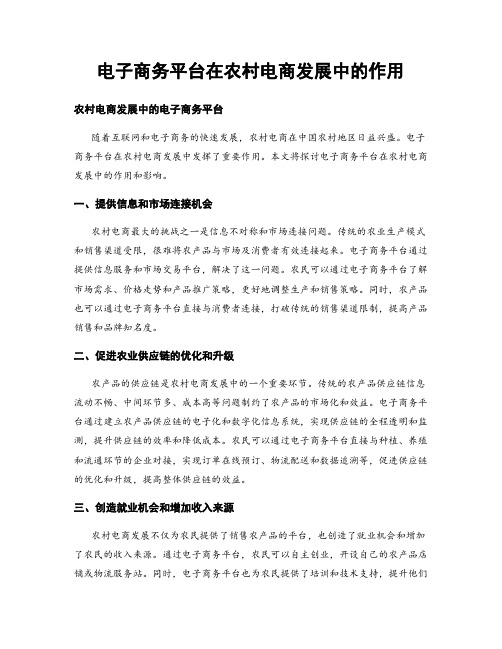
电子商务平台在农村电商发展中的作用农村电商发展中的电子商务平台随着互联网和电子商务的快速发展,农村电商在中国农村地区日益兴盛。
电子商务平台在农村电商发展中发挥了重要作用。
本文将探讨电子商务平台在农村电商发展中的作用和影响。
一、提供信息和市场连接机会农村电商最大的挑战之一是信息不对称和市场连接问题。
传统的农业生产模式和销售渠道受限,很难将农产品与市场及消费者有效连接起来。
电子商务平台通过提供信息服务和市场交易平台,解决了这一问题。
农民可以通过电子商务平台了解市场需求、价格走势和产品推广策略,更好地调整生产和销售策略。
同时,农产品也可以通过电子商务平台直接与消费者连接,打破传统的销售渠道限制,提高产品销售和品牌知名度。
二、促进农业供应链的优化和升级农产品的供应链是农村电商发展中的一个重要环节。
传统的农产品供应链信息流动不畅、中间环节多、成本高等问题制约了农产品的市场化和效益。
电子商务平台通过建立农产品供应链的电子化和数字化信息系统,实现供应链的全程透明和监测,提升供应链的效率和降低成本。
农民可以通过电子商务平台直接与种植、养殖和流通环节的企业对接,实现订单在线预订、物流配送和数据追溯等,促进供应链的优化和升级,提高整体供应链的效益。
三、创造就业机会和增加收入来源农村电商发展不仅为农民提供了销售农产品的平台,也创造了就业机会和增加了农民的收入来源。
通过电子商务平台,农民可以自主创业,开设自己的农产品店铺或物流服务站。
同时,电子商务平台也为农民提供了培训和技术支持,提升他们的销售与经营能力。
更重要的是,电子商务平台可以将传统农村的土特产品推向全国乃至全球市场,扩大销售渠道和增加销售额,从而有效提升农民的收入水平。
四、推动农村经济结构的调整和升级农村电商的发展促进了农村经济结构的调整和升级。
传统农村以农业为主导,农产品销售受限,农民收入较低。
电子商务平台的发展使农民可以通过网购、电商代理等方式参与到其他行业的经营和销售中,拓宽了就业渠道和收入来源。
浅析中国农业领域电子商务的应用与发展
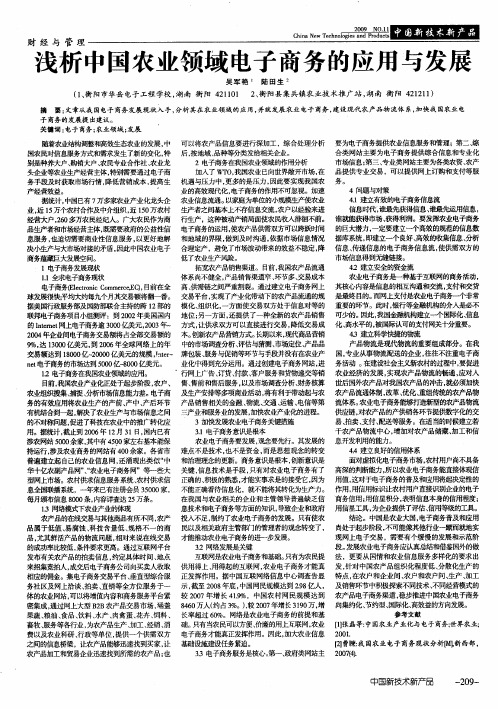
子 商务的发展提 出建议 。 关键词 : 电子商务 ; 农业领 域; 发展
的发展 , 可以将农产品信息要进行深加工,综合处理分析 中 国农民对信息服务方式和需求发生了新的变化 , 特 后, 按地域、 品种等分类发给相关企业。 2电子商务在我国农业领域的作用分析 别是种养大户、 购销大户、 民 农 专业合作社、 农业龙 头企业等农业生产经营主体, 特别需要通过电子商 加入了 WT 我国农业已向世界敞开市场, O, 在 更多的是压力 , 因此要实现我国农 务手段及时获取市场行情 , 降低营销成本 , 提高生 机遇与压力中 , 业的高效现代化, 电子商务的作用不可忽视。加速 产经营效益。 以家庭为单位的小规模生产使农业 据统计, 中国已 7 有 万多家农业产业化龙头企 农业信息流通。 农户以经验来进 业 , 1 万个农村合作及中介组织, 10 近 5 近 5 万农村 生产者之间基本上不存信息交流 , 这种被动产销局面使农民收人徘徊不前。 经营大户 , 0 2 多万农 民经纪人。广大农 民 为商 行生产 , 6 作 品生产者和市场经营主体 , 既需要政府的公益性信 电子商务的运用, 使农产品供需双方可以跨跃时间 息服务, 也迫切需要商业性信息服务 , 以更好地解 和地域的界限 , 做到及时沟通 , 依据市场信息情况 决小生产与大市场对接的矛盾, 中国农业电子 合理定产,避免了市场波动带来的效益不稳定, 因此 降 商务蕴藏巨大发展空间。 低了农业生产风险。 拓宽农产品销售渠道。目 , 前 我国农产品流通 1电子商务发展现状 体系尚不健全 , 产品销售渠道窄、 环节多、 交易成本 1 全求电子商务现状 . 1 电子商务 l t n o m r , ) e r i Cm e e C, co c c E 目前在全 高、 供需链之间严重割裂。通过建立电子商务 网上 球发展很快; 平均大约每九个月其交易额将翻一番。 交易平台, 实现了产业化带动下 的 农产品流通 的规 组织化 , 一方面使交易双方处于信息对等的 据美国行政服务 部及国防部联合主持的跨 1 部的 模化 、 2 另一方面 , 还提供了一种全新的农产品销售 联邦电子商务项 目 小组测评 : 20 年美国国内 地位 ; 到 02 的 It t n me网上电子商 e 务逾 3o 亿 元 , 0 年~ 方式 , Oo ∈ 2 3 0 让供求双方可 以直接进行交易, 降低交易成 20 年企业间电子商务交易额将占全部交易额的 本。 04 创新农产品营销方式。 长期以来, 现代商品营销 评估与猜测、 市场定位、 产品品 9o达 100 O, 30 亿美元 , 20 年全球网络上 的年 中的市场调查分析、 / 到 06 交易额达到 100 200 80 亿 ̄00 亿美元 的规模 , t— 牌包装、  ̄e nr 服务与促销等环节与手段并没有在农业产 业化中得到充分运用。通过创建 电子商务网站, 进 nt e电子商务的市场达到 50 .oo 00z- o 亿美元 。 4 s . 行网上广告 、 订货、 、 付款 客户服务和货物递交等销 1 电子商务在我国农业领域的应用。 2 ’ 售前和售后服务 , 以及市场调查分析、 财务核算 目 我国 前, 农业产业化正处于起步阶段 , 农户、 售、
中国农村电子商务发展的现状与前景
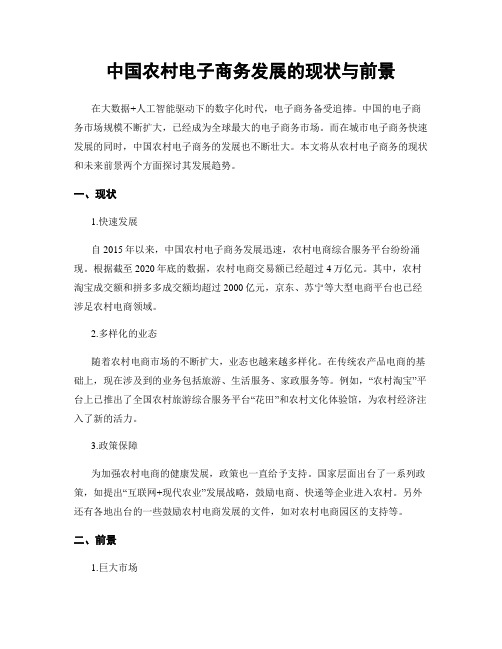
中国农村电子商务发展的现状与前景在大数据+人工智能驱动下的数字化时代,电子商务备受追捧。
中国的电子商务市场规模不断扩大,已经成为全球最大的电子商务市场。
而在城市电子商务快速发展的同时,中国农村电子商务的发展也不断壮大。
本文将从农村电子商务的现状和未来前景两个方面探讨其发展趋势。
一、现状1.快速发展自2015年以来,中国农村电子商务发展迅速,农村电商综合服务平台纷纷涌现。
根据截至2020年底的数据,农村电商交易额已经超过4万亿元。
其中,农村淘宝成交额和拼多多成交额均超过2000亿元,京东、苏宁等大型电商平台也已经涉足农村电商领域。
2.多样化的业态随着农村电商市场的不断扩大,业态也越来越多样化。
在传统农产品电商的基础上,现在涉及到的业务包括旅游、生活服务、家政服务等。
例如,“农村淘宝”平台上已推出了全国农村旅游综合服务平台“花田”和农村文化体验馆,为农村经济注入了新的活力。
3.政策保障为加强农村电商的健康发展,政策也一直给予支持。
国家层面出台了一系列政策,如提出“互联网+现代农业”发展战略,鼓励电商、快递等企业进入农村。
另外还有各地出台的一些鼓励农村电商发展的文件,如对农村电商园区的支持等。
二、前景1.巨大市场农村电商已经成为中国电商市场中不可忽视的重要力量。
对于电商平台,农村市场的规模正在与城市市场相当。
据了解,今年中国农村电商市场总交易额预计将超过5万亿元,这个数字同城市电商一样巨大。
2.颠覆传统农村电商的发展,正在为农村经济注入新的活力。
传统农业模式在物资交流、信息共享方面亟需改进,而农村电商通过建立电商平台,给农民带来新的经济收入,为传统农业模式注入了新的活力。
农村电商还可以打破地域限制,让更多优质农产品走出乡村,进入城市。
3.数字化升级随着科技的发展,数字化已经走进了农村,开始改变传统农业的生产和贸易方式。
数字化的升级将进一步推动农村电商的发展,让农民获得更多的信息和服务。
4.农村多元化近年来,城市化已使许多城市迅速建设和变得繁荣。
农业电商与乡村振兴

农业电商与乡村振兴标题:农业电商与乡村振兴引言概述:随着互联网技术的不断发展,农业电商逐渐成为推动农业现代化和乡村振兴的重要力量。
农业电商通过线上线下结合的方式,为农产品销售提供了新的渠道,促进了农村经济的发展,助力乡村振兴战略的实施。
一、农业电商为农产品销售提供新渠道1.1 农产品线上销售农业电商平台为农产品提供了线上销售的机会,农民可以通过电商平台直接销售农产品,减少中间环节,提高销售效率。
1.2 农产品线下配送农业电商通过建立物流配送网络,实现农产品的快速配送,解决了农产品销售中的最后一公里问题,提升了消费者的购买体验。
1.3 农产品品牌化推广农业电商平台能够匡助农产品进行品牌化推广,提升产品知名度和美誉度,增加产品附加值,提高农产品的市场竞争力。
二、农业电商促进农村经济发展2.1 带动农产品加工业农业电商的发展带动了农产品加工业的发展,促进了农产品的深加工,提高了农产品附加值,增加了农民的收入。
2.2 促进乡村旅游业农业电商推动了农村特色旅游业的发展,吸引了更多游客前来体验农村生活,促进了当地农产品的销售。
2.3 增加农村就业机会农业电商的兴起为农村创造了更多的就业机会,吸引了一大批年轻人返乡创业,促进了农村经济的多元发展。
三、农业电商助力乡村振兴战略实施3.1 促进农村产业结构升级农业电商的发展促进了农村产业结构的升级,推动了传统农业向现代农业的转变,提高了农村经济的竞争力。
3.2 优化农村资源配置农业电商平台能够优化农村资源配置,匡助农产品实现精准销售,提高资源利用效率,推动乡村振兴战略的实施。
3.3 促进农村数字化发展农业电商的发展推动了农村数字化发展,提高了农民的信息化水平,促进了农村经济的现代化。
四、农业电商面临的挑战与发展方向4.1 电商平台建设农业电商平台建设需要投入大量资金和技术支持,如何建设完善的电商平台是当前面临的挑战之一。
4.2 农产品质量保障农产品质量是农业电商发展的重要保障,如何保证农产品的质量和安全也是一个亟待解决的问题。
中国农业电子商务发展面临的问题
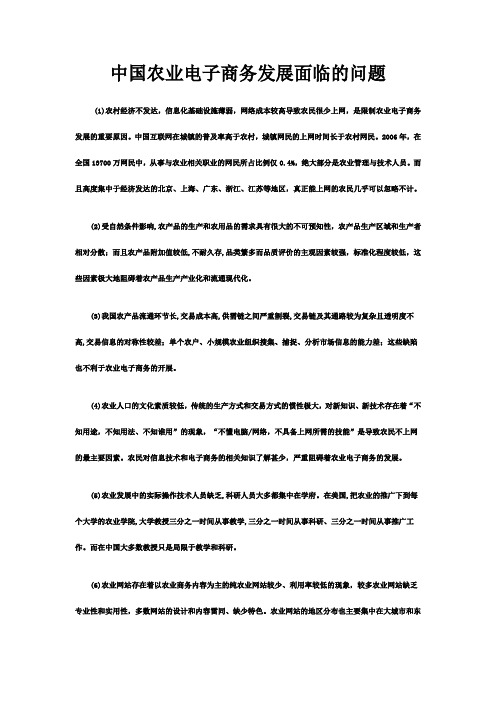
中国农业电子商务发展面临的问题(1)农村经济不发达,信息化基础设施薄弱,网络成本较高导致农民很少上网,是限制农业电子商务发展的重要原因。
中国互联网在城镇的普及率高于农村,城镇网民的上网时间长于农村网民。
2006年,在全国13700万网民中,从事与农业相关职业的网民所占比例仅0.4%,绝大部分是农业管理与技术人员。
而且高度集中于经济发达的北京、上海、广东、浙江、江苏等地区,真正能上网的农民几乎可以忽略不计。
(2)受自然条件影响,农产品的生产和农用品的需求具有很大的不可预知性,农产品生产区域和生产者相对分散;而且农产品附加值较低,不耐久存,品类繁多而品质评价的主观因素较强,标准化程度较低,这些因素极大地阻碍着农产品生产产业化和流通现代化。
(3)我国农产品流通环节长,交易成本高,供需链之间严重割裂,交易链及其通路较为复杂且透明度不高,交易信息的对称性较差;单个农户、小规模农业组织搜集、捕捉、分析市场信息的能力差;这些缺陷也不利于农业电子商务的开展。
(4)农业人口的文化素质较低,传统的生产方式和交易方式的惯性极大,对新知识、新技术存在着“不知用途,不知用法、不知谁用”的现象,“不懂电脑/网络,不具备上网所需的技能”是导致农民不上网的最主要因素。
农民对信息技术和电子商务的相关知识了解甚少,严重阻碍着农业电子商务的发展。
(5)农业发展中的实际操作技术人员缺乏,科研人员大多都集中在学府。
在美国,把农业的推广下到每个大学的农业学院,大学教授三分之一时间从事教学,三分之一时间从事科研、三分之一时间从事推广工作。
而在中国大多数教授只是局限于教学和科研。
(6)农业网站存在着以农业商务内容为主的纯农业网站较少、利用率较低的现象,较多农业网站缺乏专业性和实用性,多数网站的设计和内容雷同、缺少特色。
农业网站的地区分布也主要集中在大城市和东部发达地区,中部和西部地区的网站并不多。
这些都导致网站不能因地制宜地为更多地区的农民提供全面的、周到的、符合实际需要的服务。
农产品电商平台的市场规模及发展趋势

农产品电商平台的市场规模及发展趋势一、市场规模近年来,随着中国消费市场的不断扩大和互联网技术的普及,农产品电商平台逐渐成为农业经济的重要组成部分。
据国家统计局数据显示,2019年全国农产品电子商务市场交易额达到1.4万亿元,占全国社交零售总额的比重超过20%。
其中,农村电商交易额占到全国农产品电子商务市场交易额的40%以上。
具体来看,蔬菜、水果、肉类、海鲜等大宗农产品均已成为农产品电商平台上的热销品类。
而随着人们健康饮食意识的提升和生活质量的改善,一些高端的绿色、有机农产品和进口农产品也成为了消费者关注的热点品类。
二、发展趋势1.农产品电商平台规模将继续扩大随着互联网技术和物流技术的不断发展,农产品电商平台规模将继续扩大。
未来,更多的农产品将在电商平台上销售,同时消费者对于农产品品质、安全性和健康价值的需求也将不断提高,在这种情况下,农产品电商平台的市场空间将进一步扩大。
2.绿色、有机农产品将成为新的增长点随着社会环保意识的提高和消费者健康意识的增强,绿色、有机农产品已经成为现代消费者购买农产品的新趋势。
在未来,随着人们对食品安全和健康的需求不断提高,绿色、有机农产品将成为农产品电商平台的新的增长点。
3.互联网+农业将推动农产品电商平台的发展互联网+农业是未来农产品电商平台发展的趋势,通过大数据、云计算、人工智能等互联网技术手段,可以提高农业生产效率,提高产品品质和安全性,降低成本,进一步推动农产品电商平台的发展。
4.物联网技术将助力冷链物流的发展物联网技术可以实现对冷链物流温度、湿度等环境变量的监测和控制,保证农产品在运输过程中的品质和新鲜度,这将为农产品电商平台的发展提供更完善的物流保障。
5.社交电商将成为新的发展方向社交电商是指在社交媒体平台上运营的电商模式,它将社交和电商相结合,能够更好地满足消费者的个性化需求。
未来,在农产品电商平台上,社交电商将成为新的发展方向。
三、总结随着中国农产品电商平台市场的不断扩大和发展,农业经济将逐渐向着数字化、智能化方向发展。
-中国农产品电子商务发展报告

中国农产品电子商务发展报告一、发展现状1. 市场规模逐年扩大近年来,我国农产品电子商务市场规模呈现高速增长态势。
根据相关数据显示,2018年我国农产品电子商务市场规模达到1800亿元,同比增长28.5%,预计2020年市场规模将突破2500亿元。
2. 电商平台不断涌现在农产品电子商务市场,各类电商平台纷纷涌现,既有天猫、京东等综合类电商平台,也有拼多多、云集等社交电商平台,还有农淘、农村淘宝等专业农产品电商平台。
这些平台的崛起为农产品线上交易提供了广阔的舞台。
3. 产业链整合加速农产品电子商务的发展推动了产业链的整合,从生产、加工、储存、物流到销售环节,各个环节都在逐步实现线上线下融合,提高了产业效率。
同时,农产品电子商务平台也在积极拓展农村市场,助力农民增收。
4. 政策支持力度加大近年来,国家高度重视农产品电子商务发展,出台了一系列政策措施,如《关于促进农村电子商务加快发展的意见》、《农业农村部等部委关于推进农村电商物流仓储体系建设的指导意见》等,为农产品电子商务发展提供了有力保障。
二、面临挑战1. 品质把控难度大农产品具有易腐烂、保质期短等特点,因此在物流运输和储存环节容易出现品质问题。
农产品产地分散、标准化程度低,也给品质把控带来了一定的难度。
2. 物流配送体系不健全虽然我国农产品电子商务市场规模不断扩大,但物流配送体系尚不健全,特别是农村地区的物流配送能力不足,成为制约农产品电子商务发展的瓶颈。
3. 人才短缺农产品电子商务涉及多个领域,如生产、加工、物流、营销等,需要各类人才共同推进。
然而,当前农村地区人才短缺,特别是电商专业人才匮乏,影响了农产品电子商务的发展。
4. 市场竞争加剧随着越来越多的企业和资本进入农产品电子商务市场,市场竞争日益加剧。
如何在激烈的市场竞争中脱颖而出,成为各大电商平台面临的关键问题。
三、发展建议1. 加强政策支持,优化发展环境继续加大对农产品电子商务的政策支持力度,优化发展环境,引导和鼓励各类电商平台创新和发展。
- 1、下载文档前请自行甄别文档内容的完整性,平台不提供额外的编辑、内容补充、找答案等附加服务。
- 2、"仅部分预览"的文档,不可在线预览部分如存在完整性等问题,可反馈申请退款(可完整预览的文档不适用该条件!)。
- 3、如文档侵犯您的权益,请联系客服反馈,我们会尽快为您处理(人工客服工作时间:9:00-18:30)。
Vol.8, No.1 (2015), pp.1-10/10.14257/ijunesst.2015.8.1.01 Construction of Agricultural E-commerce Platform in ChinaWu YanyanSchool of computer and information engineeringHarbin University of CommerceHarbin, Chinawyyhrb@AbstractThe decentralized management of agricultural production is inconsistent with the big market and circulation in China. Agricultural e-commerce platform can help connecting supply and demand better. The paper analyzes the application and characteristics of agricultural e-commerce in China and points out that the construction of agricultural e-commerce platform is the first step in the development of agricultural e-commerce. Combined with the situation and characteristics of the Chinese agriculture, several construction frames are given for the development of agricultural e-commerce platform. For example, big enterprises build third party agricultural public trade platform under the guide of the government based on market operation. And then local government may lead to construct collaborative agricultural e-commerce platform to integrate the local resources. At the same time, some strategies should also be implemented in order to realize the sustainable development of the platform, especially the application of mobile e-commerce.Keywords: agriculture, E-commerce, Third-party e-commerce, collaborative e-commerce1.IntroductionWith the quick development of information technology, e-commerce has been defined as “...the process of buying, selling, or exchanging products, services, and information via computer networks” (Turban et al., 2004). The meaning refers to all works related with the sharing of supply and demand information, maintaining relationships, and conducting transactions through networks (Zwass, 1996). Its emergence is believed to transform the conduct and structure of business (Kauffman & Waiden, 2001) [1]. For agricultural firms including producers, processors, retailers, wholesalers, e-commerce can serve as an additional trade and marketing channel. Because agricultural e-commerce platform can provide good opportunity to extend supply chain (Henderson, 1981). Generally, agricultural e-commerce may play an important role for agricultural enterprises, especially providing them an alternative communication medium with business partners and further developing their business activities through Internet [2]. The types of agricultural e-commerce platform can be distinguished in three major categories (Wilson, 2001): e-markets for the outputs of farms, namely B2C e-commerce; e-markets for the production factors and inputs of farms, namely B2B e-commerce; e-markets of services by third parties, namely professional e-commerce platform [3]. It is important to note that agricultural e-markets demonstrate different degrees of e-commerce adoption. Agricultural e-commerce is in rapid development, and many agricultural enterprises are actively adopting e-commerce, especially in China.ISSN: 2005-4246 IJUNESSTVol.8, No.1 (2015)2.E-commerce Adoption in China AgricultureAgriculture is one of the basic industries that supports all activities and pursuits of humankind. It represents an important percentage of GDP in China, ensures and creates jobs as well. With the development of information technology, agriculture also is involved in the trend. Agriculture e-commerce has become the most popular issue.China is an agricultural country, agriculture website is developing quickly. Many provinces generally not only have established "agricultural information website", but also have produced some large online market, e.g. "Fuzhou peak", "Nanjing BaiYunting" etc. Online business varieties also expands from agricultural food, fertilizer to agricultural chemicals, special local product, flowers, tea, fresh fruit and so on, which created a platform for the rural economic development.At present, there are more than 2, 000 rural e-commerce sites in China, and the agriculture web site for more than 10, 000. The agriculture websites issue much information about vegetables, fruits, trees, livestock and poultry, aquaculture and other agricultural supply and demand information and related economic, investment information. The agricultural e-commerce websites have played an important role to prompt agricultural products circulation, improve agricultural efficiency and farmers' income. Some websites have produce great influence such as China's agricultural science and technology information network (), China agricultural information network (), seed group co., LTD. (), the north China seed industry information center () and so on. This shows that China's agricultural e-commerce is into a period of rapid development. Due to December 2013, the scale of rural Internet users reached 177 million, and the rural population accounted for 28.6% of Internet users in China. China's rural Internet penetration rate reached 27.5%, and it continued to increase. All of these have provided good basis for the development of agricultural e-commerce of China [4].3.Types of Agricultural E-commerce in ChinaAccording to McKertich (2004), the nature of the agricultural sector has shaped essentially two types of e-marketplaces that address the needs of the agricultural supply chain, from livestock, dairy products, fruit and vegetables, or aquaculture, distribution, and retailing. One of them is online exchange which is typically a digital marketplace. The other one is e-marketplace, which usually provides management services to support business and generally attracts the retail and processing end of the supply chain, as the buying process is more structured and less dependent on perishability of goods [5]. In China, types of agricultural e-commerce may include as follows.3.1.Professional Agricultural e-commerce WebsitesThis type agricultural e-commerce mainly provides agricultural product supply and demand information services, agricultural products trading as a supplement and mainly facing a locality. So it can be seen as an information release platform. This type website is constructed by information and technology companies and supported by the local government which service for the local agriculture business and peasant.For example, the websites including , , and are built by network information and technological company and local or national agriculture department are information service platform. They provide information services, logistics services as an agricultural products e-commerce platform, but cannot provide online exchange.ZhongNong network () so-called the biggest agricultural products e-commerce based on traceability, provides agricultural products price index, wholesale,Vol.8, No.1 (2015) food traceability etc. agricultural products information services. But its services are mainly facing Shenzhen, Guangdong not the whole nation.Heilongjiang agriculture information website () is hosted by Heilongjiang government, providing agricultural products information in Heilongjiang province. In the whole, this type agriculture e-commerce has obviously regional characteristic, and mainly provides information of supply and demand to speed up the transaction.3.2. Agricultural Products Transaction based on Comprehensive B2B Platform.Some famous B2B platform have all provide agricultural products transaction, such as Alibaba () provides food and agriculture plate subdivided into snack market, fresh fruit market, rice grain and oil goods, drinks and tea market, maternal and infant health market. Huicong website () includes feed market, seedling market, food market. The trading volume of this type of agricultural e-commerce is less than other products, and with little attention.3.3. Professional Agricultural Products B2C PlatformThis e-commerce has been developing quickly. For example, , , , and are the professional fresh agricultural food platform. And Benlai network provides cold chain logistics in 8 hours and it is famous for the sale of “Chu orange”.So it is a better agricultural products platform in China, but it has a limited distribution business scope. And the development of SFbest is based on the SF express, but it has no use well its distribution network. And the development of Youcai and Tootoo websites is not well. Therefore, the B2C platform of agricultural products is developing difficult.4.Characteristics of Chinese Agricultural e-commerceComprehensively, at present, we can see that agricultural e-commerce in China has faced big barrier. It is mainly reflected from the following aspects:4.1. Obvious Regional CharacteristicsChina is a large country and the land area is big. There are huge types and quantity of agricultural products. At the same time, due to agricultural products have higher logistics requirements. The sale of agricultural products is limited in a small region. Therefore, China's agricultural e-commerce market has obvious regional characteristics.4.2.Mainly Provide Agricultural Prices Information ServiceMost agricultural e-commerce has not yet been formed sales model, and they mainly provide the information service such as prices, production and demand. Online payment, online marketing and other business model have not been widely used. A few fresh electric business enterprises are exploring online direct marketing model.4.3.Service Object Mainly Facing to the Final Agricultural ProductsThe main purpose of agricultural e-commerce in China is still in use of network to expand sales channels. And the sales object is the final consumer. So, the development of electronic commerce activity is to meet the needs of final consumers. And there is less e-commerce for the purpose of agricultural reprocessing. As a result, it limited the scale of agricultural e-commerce.Vol.8, No.1 (2015)4.4. Lack of Large-scale Agricultural e-commerce EnterprisesAgricultural e-commerce development in China more depends on the third-party e-commerce platform. As a result, the market structure is small and loose. There are many small and medium enterprises in the competition stage, and there has not yet formed a scale of professional electric business enterprise of agricultural products, especially the lack of large-scale agricultural enterprise websites. Moreover, agricultural e-commerce business model is similar. And most of the business is in the exploratory stage, has not formed a fixed operating mode or operating characteristics, and most enterprises have limited scale and poor profitability.4.5. Logistics Distribution is the Bottleneck and Lack of Offline Experience StoreAgricultural products have a short shelf life and perishable, so cold chain logistics in agricultural products distribution is required [6]. But at present, except a few professional fresh agricultural products e-commerce enterprises have a certain range of cold chain logistics capability. Most e-commerce companies don't have the requirement of cold chain logistics, which leads to severe constraints for the sale of agricultural products. In addition to, agricultural products are less standardized goods. And consumers’preference of agricultural products is different. So building experience shop and community distribution network is the important basis for the development of e-commerce of agricultural products.5.Construction Schemes for China Agricultural e-commerce PlatformUnder the condition of agricultural enterprises and agricultural e-commerce in China, the paper puts forward several agricultural e-commerce platform construction plans, and analyzes them in detail.5.1. E nterprise’s Own e-commerce PlatformBy changing the management and operation mode, agricultural enterprises can establish their own e-commerce platform, through increasing investment in information infrastructure construction, building internal network, as shown in Figure 1.The construction scheme is suitable for the large agricultural companies, which has relatively developed information network, good information infrastructure and wide customer base [7]. This type platform should have the following functions: relevant policies and regulations, information consulting, online product information and the query, online business negotiation, online trading, commodity distribution, after-sales service and related information etc.Figure 1. Frame of Enterprises’ Own e-commerce PlatformVol.8, No.1 (2015)5.2.Based on Third-party e-commerce Public PlatformFor the present situation of "small farmers and big market" in Chinese agriculture, the e-commerce platform need to solve the problems such as small scale, weak infrastructure, lack of effective connection between enterprises and markets, especially for the small and medium-sized agricultural entities [8]. In addition, high transaction costs, inventory pressure, low level of specialization and scale problems are also the main problems. The third parties e-commerce platform can provide the public platform to carry out the agricultural e-commerce activity suitable for SMEs, as shown in Figure 2.Figure 2. Frame of Third-party e-commerce Public Platform The construction scheme is suitable for small and medium-sized agricultural enterprises. They rely on third parties to provide the public platform of e-commerce activities, which can implement electronic commerce, and join the third-party e-commerce platform with lower cost and enjoy professional information services and value-added services [9]. It may increase opportunities for the development of the agricultural production and business operation. And the third-party e-commerce providers should utilize the commercial Web site running mechanism to set up an electronic commerce system which is cross-industry, open and service for the whole business process in the true sense [10]. Moreover, after several years of exploration and management, third-party e-commerce has been relatively mature. And at present, this e-commerce application mode is generally used in Chinese small and medium-sized agricultural business.The most basic function of the third party e-commerce mode is to provide information intermediary services for online transactions between buyers and sellers. So it should have the following functions: first of all, buyers and sellers can release their purchasing or sales information on the Internet and select potential suppliers or customers according to the published information. Second, it should provide additional information service such as industry information and sent buy and sell information to the customer regularly. Third, it should provide services matching trade, such as online contracts, online payment, etc. Fourth, provide customer management functions, namely, online transaction management, including the hosting service for the enterprise contract, transaction records, customer information.Third-party e-business pattern has changed the traditional way of working and the inherent thinking mode, which is more easily accepted by agricultural enterprises. Many agricultural production and business operation entities gathering on a third party platform can bring advantage of the new procurement, planning and decision-making for e-commerce alliance members. Third-party e-commerce model is effective to promote the development of agricultural e-commerce in China. With the support of social forces and the government, the third party agricultural e-commerce platform can provide more effective e-commerce support for more agricultural entities.Vol.8, No.1 (2015)5.3. Collaborative e-commerce PlatformCollaborative e-commerce is mainly based on the B2B e-commerce mode. And its basic idea is put forward by Gartner Group in 1999. It utilizes information network technology, through integrated business platform to provide business integration, information sharing and collaborative work for the enterprise and its partners. It can realize information collaboration, internal and external coordination to develop an effective value chain [11]. According to the basic idea of collaborative e-commerce, agricultural entities can be combined and in accordance with the system theory and synergetics they can build the e-commerce platform composed by “supply,production and sales” chain and integration of modern management techniques (CRM, SCM, etc.,) which can build a virtual integration market. The frame structure is shown in Figure 3.Figure 3. Frame of Collaborative e-commerce Platform Collaborative e-commerce will effectively reduce the development cost of agricultural e-commerce platform. Using the collaborative e-commerce can make enterprises expand in the whole supply chain even global supply chain, and make highly flexible, rapid response virtual enterprises. And it may realize the services business model and business integration for the mining, processing, design, production, distribution, transportation, and marketing in global.Collaborative e-commerce should have collaboration in technology, application and service. Technology collaboration refers to using software component technology, such as middleware technology and service-oriented architecture (SOA) technology to make the platform has good integration, scalability, portability and consistency to ensure the sharing of information resources. Application collaboration refers to utilize SCM, CRM, and other modern management technology, make a huge virtual market. Service collaboration is to create a service chain of supply, production, sales service by enterprise alliance.5.4. International Agricultural e-commerce PlatformEstablishing international e-commerce platform with characteristics is one of the effective means to exploit the international market, which can make full use of the Internet convenience and advantage. It is also an effective way to show enterprise image when agricultural enterprises participate in international competition. As shown in Figure 4.Vol.8, No.1 (2015)Figure 4. Frame of International e-commerce Platform This kind of platform is suitable for the enterprises or enterprises alliance. They want to explore international market, have the international market competitiveness, and the production of agricultural products has won the international quality certification [12]. The platform should have the following functions: product information release system, online customer consultation system, the international order query system, customer feedback system, customer service centers, investment opportunities, product knowledge, FAQ, a global sales network, the global procurement system, etc. International e-commerce platform should achieve the goals including: international customers can order or feedback information directly through the platform, to release the latest product information and development of the enterprise and to collect the latest information reference, more importantly, it should realize the online trading of international trade, global sourcing and distribution and so on, eventually reduce business costs, improve work efficiency, improve the competitiveness.6.Construction Strategies for Chinese Agricultural e-commerce PlatformEstablishing agricultural e-commerce platform is the first step, in order to build agricultural e-commerce platform, promote the rapid development of agricultural e-commerce, the following several aspects should be followed.6.1.Choose the Proper Agricultural e-commerce Platform Construction SchemeFor few large agricultural enterprises with better information infrastructure, they can choose to build their own e-commerce platform, and through the Internet to realize the internationalization of e-commerce. For most small and medium enterprises, they can rely on third-party e-commerce platform to implement electronic commerce. And for the enterprise alliance with closely business links and intensive management they can build collaborative e-commerce platform by the method of integration. And for enterprises or enterprise alliance with strong market competitiveness and trying to develop the global market, they can set up international e-commerce platform, participating in international competition.6.2.Strengthen the Promotion of Agricultural e-commerce PlatformNo matter adopting what kind of solution to set up e-commerce platform, propaganda and promotion must be done which can expand the visits and win the attention and recognition [13]. At that time, we should pay attention to: the platform design should have agricultural characteristics; it must have a good safety and interactive; in the public media to release website information; to publish online advertising, set up links, send an email to potential customers; to set up their own position in search engines to let potential customers find themselves.Vol.8, No.1 (2015)6.3.Perfect Functions of Agricultural e-commerce PlatformAt present, a lot of agricultural e-commerce platform only have static information, this is obviously not enough. And a good agricultural e-commerce platform must provide latest information quickly, and at the same time, it also should provide the following functions: product information, online customer consultation, online payment transaction, logistics, customer service, investment opportunities etc. Only a fully functional e-commerce platform can win more business opportunities.6.4.Develop Mobile Agricultural e-commerceMobile client access to the electronic commerce has become the new hot spot and tendency of the development of the electronic commerce. In several online equipment, rural Internet users more choose mobile phone to access to the Internet, the proportion of using mobile phone is higher than that of using the rest of the equipment are all below the town. As of December 2013, in rural areas the proportion of Internet users use mobile Internet has reached 84.6%, 5% higher than that in cities and towns [14]. Mobile Internet with the advantage of low cost, easy to operate has been becoming the mainstream of access to the Internet. Therefore, agricultural e-commerce platform should also actively launch mobile e-commerce client, speed up the popularization of mobile agricultural e-commerce.7.ConclusionsE-commerce has just been developing quickly in China. Agricultural e-commerce is also facing the huge opportunity, and serious challenges. There are still many questions to face and many difficulties need to be solved. The construction of agricultural e-commerce platform can only build from the fact and only in this way the sales market of agricultural products can be opened. Only break the regional limitation, national boundaries and participate in international competition, Chinese agriculture enterprises can success in the global competition. Therefore, the discussion of the construction of agricultural e-commerce platform may have a reference for the development of agricultural e-commerce in China.AcknowledgementsThe paper is supported by Heilongjiang Philosophy and Social Science Fund NO.14B008.References[1]N. Manouselis, A. Konstantas, N. Palavitsinis,C. Costopoulou and A. B. Sideridis, “A Survey of GreekAgricultural E-Markets”, Agricultural Economics Review, vol. 10, no. 1, (2009), pp. 97-112.[2] E. Cloete and M. Doens, “B2B e-Marketplace Adoption in South African Agriculture”, InformationTechnology for Development, vol. 14 , no. 3, (2008), pp. 184–196.[3]S. D. Zapata, C. E. Carpio, O. Isengildina-Massa and R. Dave Lamie, “The Economic Impact ofServices Provided by an Electronic Trade Platform: The Case of MarketMaker”, Journal of Agricultural and Resource Economics, vol. 38, no. 3, (2013), pp. 359–378.[4]“China internet network development statistic report”, (2014), /hlwfzyj/ hlwxzbg/.[5]Rolf A. E. Mueller, “E-Commerce and Entrepreneurship in Agricultural Markets”, American Journal ofAgricultural Economics, vol. 83, vol. 5, (2001), pp. 1243–1249.[6] D. Lv and Q. Zhou, “Development model of agricultural E-commerce in the context of socialcommerce”, Journal of Chemical and Pharmaceutical Research, vol. 6, no. 7, (2014), pp. 1341-1345. [7]J. Henderson, F. Dooley and J. Akridge, “Inernet and E-commerce Adoption by agricultural inputfirms”, Review of Agricultural Econmics, vol. 26, no. 4, (2003), pp. 505-520.[8] F. Montealegre, S. Thompson, and J. S. Eales, “An Empirical Analysis of the Determinants of Successof Food and Agribusiness E-Commerce Firms”, International Food and Agribusiness Management Review, vol. 10, (2007), pp. 61–81.Vol.8, No.1 (2015) [9] E. Brynjolfsson and L. M. Hitt, “Beyond Computation: Information Technology, OrganizationalTransformation and Business Performance”, J.Econ. Perspective, vol. 14, (2000), pp. 23-48.[10]Zoujin, “Analyze on Chinese agricultural third-party e-commerce mode”, Business Times, vol. 5,(2007), pp. 24-25.[11] C. Subramaniam and M. J. Shaw, “A Study of the Value and Impact of B2B E-Commerce: The Case ofWeb-Based Procurement”, International Journal of Electronic Commerce, vol. 6, (2002), pp. 19–40. [12]J. C. Whitehead, T. J. Hoban and W. B. Clifford, “Willingness to Pay for Agricultural Research andExtension Programs”, Journal of Agricultural and Applied Economics, vol. 33, pp. 91–101, (2001). [13] A. L. Fruhling and L. A. Digman, “The Impact of Electronic Commerce on Business-Level Strategies”,Journal of Electronic Commerce Research, vol. 1, (2000), pp. 13–22.[14]“China mobile internet report”, (2014), /hlwfzyj/hlwxzbg/Vol.8, No.1 (2015)。
